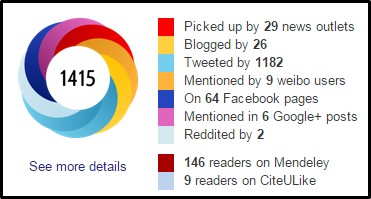Psychological Science Debuts New Article Metrics
Congratulations! You have just published your research in a well-respected academic journal. But now what? Are people looking at your article? Are they talking about it and sharing it with others?
When researchers want to see the reach or impact of an article they have written, they often look to see how many people have cited their paper. Although citations are an indication of how an individual article is used by the research community, they do not indicate interest in the article that comes from nonresearch sources or the public.
With this in mind, SAGE is now including new article metrics on Psychological Science’s website so that readers can get a real-time look at how an article is being shared by different people on a variety of different media platforms.
To view article metrics, readers should select an individual article and then locate the “Article Metrics” link in the right-hand sidebar under the “Services” heading. Clicking this link will take you to the Article Metrics and Usage Statistics Center for the current article.

In addition to usage information, this page displays a numerical and pictorial representation of how an article is being shared. On the right, readers can see how many times the article has been mentioned in news outlets, blogs, tweets, Weibo, Facebook, and google+ posts. On the left, users can see a doughnut-shaped representation of these mentions, allowing for a quick comparison of how the article has been shared on different media platforms.
Within the doughnut is a score meant to quantify the article’s exposure – and hopefully influence. This score is created by analyzing the number and type of mentions the article has received. The higher the score, the more attention an article has received.
Clicking on the “See more details” link located below the doughnut leads to a page with detailed information on the article’s exposure, such as links to individual blog posts that mention the article, lists of tweets and demographic information on the tweeters sharing the article, and more information on how the article score compares with those of other Psychological Science articles of a similar age.
Article metrics are a valuable tool Psychological Science authors and readers can use to gauge the real-world impact of an article. So take a moment and look up your favorite article (we won’t judge you if it’s your own) and see how many other people out there may be counting it among their favorites.
Article Metrics are coming to articles in all of APS’s journals in summer 2015.





Comments
I do not have a tweeter account, nor a Google+ account, nor weibo account. I don’t blog and I don’t reddit. Does it mean that authors who do engage in social networks will likely to have higher scores? Is there a mechanism to distinguish self-promotion and true public consumption?
APS regularly opens certain online articles for discussion on our website. Effective February 2021, you must be a logged-in APS member to post comments. By posting a comment, you agree to our Community Guidelines and the display of your profile information, including your name and affiliation. Any opinions, findings, conclusions, or recommendations present in article comments are those of the writers and do not necessarily reflect the views of APS or the article’s author. For more information, please see our Community Guidelines.
Please login with your APS account to comment.